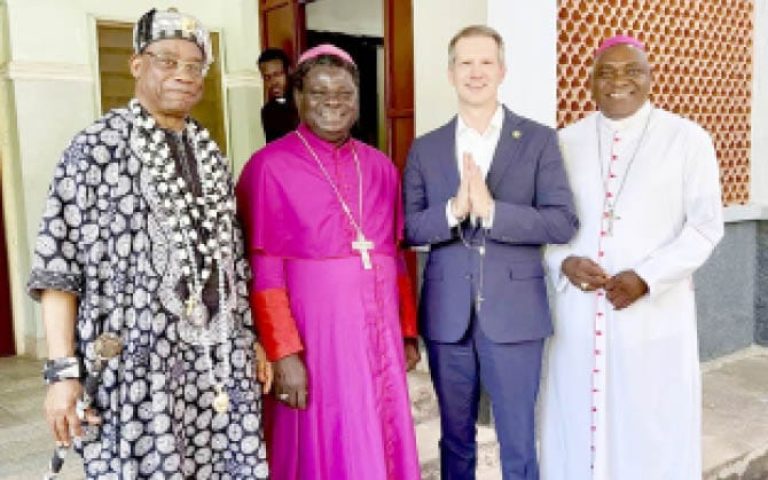At least 700 communities in six states have been sacked by banditry and ethnoreligious conflicts. Hundreds of thousands of people have also been displaced, causing a humanitarian crisis that has rattled economic activities and peaceful co-existence in Nigeria’s North-West and North-Central. From Sokoto to Zamfara, Katsina, Kaduna, Plateau and Niger states, hundreds of communities have been deserted, others occupied by bandits, from where they launch incessant attacks on other communities.
Some data from government emergency agencies on a number of communities sacked appear erratic or non-existent, but residents and community leaders of affected communities warn that unless checked, the activities of bandits could further push more communities into the hands of non-state actors, who continue to advance and occupy major towns across northern Nigeria’s massive land space.
In Niger, over 300 communities sacked
Niger State is unarguably becoming Nigeria’s epicentre of banditry activities, with over 308 communities sacked in 11 local government areas. The state, which is Nigeria’s largest in terms of landmass, is situated in the North-Central and shares borders with Kebbi, Zamfara, Kaduna, Kogi, Kwara states and the Federal Capital Territory (FCT). It also shares a border with the Benin Republic.
However, in the last few years, as many as 308 communities in Rafi, Shiroro, Bosso, Munya, Paikoro, Mariga, Kontagora, Magama, Mashegu, Wushishi and Rijau local government areas of the state have become ghost communities following incessant attacks on residents by bandits.
A breakdown of the official data exclusively obtained from the Niger State Emergency Management Agency (NSEMA) shows that as at February 14, 2022, at least 50 communities were deserted in Rafi Local Government Area, out of which 30, 678 residents now live as displaced persons in Kagara Central Primary School and Pandogari Primary School, while some are taking refuge in neighbouring communities, including Tegina town.
The document showed that in Shiroro Local Government Area, 28 communities have been sacked and 29, 987 persons displaced, while 38 communities have been sacked in Munya Local Government, with 19, 712 persons displaced.
The director-general of the NSEMA, Ibrahim Ahmed Inga, said 47 communities had been sacked in Mariga Local Government; 17 in Paikoro; 9 in Bosso; eight in Kontagora; 48 in Magama; 31 in Mashegu; 23 in Wushishi and 9 in Rijau.
He, however, said that due to constant attacks on more communities, the figure was more likely to rise. “Majority of displaced persons still require additional provision of food and non-food items to supplement the dry ration provided by the state government. There is a need for support from non-governmental organisations and donor partners to augment the effort of government,” he said.
He said the primary schools where displaced persons sought refuge had become congested and inadequate, adding that not less than 50 women and children occupy a classroom.
Over 140 communities deserted in Kaduna
There are at least over 100 communities that have been displaced in Kaduna State following years of attacks across communities affected by banditry, as well as due to the state’s multi-layered ethnoreligious and farmer/herder conflicts that have lasted for decades.
A December 2020 report published by Daily Trust sampled about 143 villages in seven local government areas of Zangon Kataf, Kauru, Birnin Gwari, Chikun, Giwa, Igabi and Kajuru, which were sacked.
A breakdown of the figure shows that 16 communities had been sacked in Chikun Local Government, including Unguwan Rahama, Tarugu, Badayi and Dakwala, while five communities, including Nasarawan Sabon Sara, Hayin Kobo, Rafin Kaji and Marke had been saked in Giwa Local Government. In Kajuru, 26 villages, amongst them Itsi, Mashingin and Pushu have been deserted; and in Birnin Gwari, 60 villages, including Tsiron Gwari, Madama, Gaban Falagi and Goran Dutse are now ghost communities. Kauru Local Government Area has Kiztin and Kitsarapang communities deserted, while Zangon Kataf has Kurmin Gandu and Gidan Zaki as deserted. In Kachia, as many as 32 communities, including Chikwale, Idum and Muruchi were deserted.
Confirming the data from Birnin Gwari, the Birnin Gwari Emirate Progressives Union (BEPU) said that in the local government area alone, about 60 villages were sacked by bandits as at 2021. The chairman of the union, Salisu Haruna, a lawyer, said, “No human being lives there. The people from those villages, who are largely farmers, have been forcefully sent on exile by bandits.”
Daily Trust Saturday reports that as at March 1, 2022, official records of the Southern Kaduna Peoples Union (SOKAPU) shows that at least 145 communities scattered in six local government areas had been displaced.
The president of the SOKAPU, Jonathan Asake, said 28 communities, including Kihoro-Libere, Bakin Kogi, Umiko, Magunguna and Idazo, had been sacked in Kajuru Local Government, while 33 communities, including Chikwale, Idum, Muruchi and Kwasau Legede were displaced in Kachia.
Asake said 45 communities had been sacked in Chikun Local Government, while eight were sacked in Kaura and nine in Kauru, while Zangon Kataf had 22 displaced villages. He, however, said efforts had been made by some of the displaced persons to return to their communities, and cited examples with Idazo, Unguwan Shaba and Magunguna villages in Kajuru Local Government, where some residents returned to clear their farms.
However, records provided by the Kaduna State Emergency Management Agency (NSEMA) shows that only 52 communities were sacked by bandits in six local government areas from 2021 till date. Although the SEMA could not provide an aggregate figure of deserted communities prior to 2021, its executive secretary, Muhammed Mu’azu Mukaddas, told Daily Trust Saturday that 52 communities reflected communities where the agency conducted assessments. Mukaddas said there were other areas the agency could not assess due to insecurity.
Based on the agency’s data, only one community was sacked in Giwa Local Government, three in Birnin Gwari and four in Kajuru, as at 2021. It stated that one community had also been sacked in Chikun and seven others in Igabi and 26 communities sacked in Zangon Kataf, within the same year.
In 2022, the agency stated that 21 communities were displaced in four local government areas, with Kajuru having two, Birnin Gwari, 16, Zongon Kataf, one and Kaura, two.
Zamfara records over 100 deserted communities
In Zamfara State, horrific raids and kidnappings have left over 100 communities deserted, forcing about 600,000 people to flee, abandoning farming and herding in 14 local government areas. Official data from the state’s Ministry of Disaster Management and Humanitarian Affairs was unavailable, but unofficial data from a staff of the ministry who was not authorised to speak, put the number of sacked communities at 123 as at December 2021.
Our correspondent gathered that in Anka Local Government, many communities, including Tamuzge, Sabuwar Tunga, Tungar Daji, Tashar Birai, Tintija, have been deserted since 2018. Further checks by Daily Trust Saturday revealed that about six villages were abandoned by residents in the Kware district of Shinkafi Local Government. Residents confirmed that communities such as Atarawa, Ursasa, Farin Dutse, Unwala, Kukar Banda and Gobirawa have been deserted.
In Dansadau district in Maru Local Government, it was gathered that about 30 villages have been deserted, among them Mai Getso, Kamgam, Mai Rediyo, Saulawa, Gangaren Aura and Gidan Hanza. The story is the same in Tsafe Local Government, where communities such as Asaula and Rugumawa, I, II and III have since become shadows of their former selves, according to a resident identified as Aminu Muhammad.
Another resident, Alhaji Abubakar Usman, told our correspondent that cases of desertion increased in recent times.
In Maradun Local Government Area, communities like Malamai, Falau, Gwargwawo, Dale, Fasawa, Katohin, Unguwar Mallam and Bare-Bare in Magami district of Gusau Local Government have all been deserted.
In Plateau, Lalong’s hometown among 100 sacked communities
Plateau’s decade of complex ethno-religious crisis, farmer/herder conflicts, banditry and communal clashes have led to the displacement of over 50,000 people and at least 104 communities sacked. Data obtained by Daily Trust Saturday from the Plateau Peace Building Agency shows that between 2001 and 2020, at least 104 communities in Riyom, Barkin Ladi, Bokkos and Bassa local government areas have been sacked. However, our correspondent could not authenticate if these communities are still unoccupied as the state government, in collaboration with Operation Safe Haven, had in December 2018 repatriated some displaced persons.
Before the repatriation, the report of a seven-man committee set up by the Plateau State governor, Simon Bako Lalong, to work on modalities for the safe return of all displaced persons in 2018 had disclosed that 50,212 people had been displaced from their abodes since 2010, while 118 communities and 89 Fulani settlements had been affected in Jos North, Riyom, Barkin Ladi, Bassa and Bokkos local government areas.
However, a breakdown of the data obtained by the Plateau Peace Building Agency shows that 10 communities, including Krunkwa, Rotsu, Nzhwego were sacked in Bassa Local Government in 2017, while nine communities, including Hotom Wereng, FubokMandung and Ganda communities had been sacked in Bokkos. Riyom and Barkin Ladi local government areas, which herder crisis, have 85 communities that have been sacked.
According to the data obtained from the National Emergency Management Agency (NEMA) in Plateau State, 41 communities were displaced from seven local government areas of the state as at January 1, 2022. The data, which was collated using the displacement tracking metrics, in collaboration with the State Emergency Management Agency (SEMA), International Organisation for Migration (IOM), local government councils and community leaders, stated that communities sacked included that of Governor Simon Bako Lalong, Ajikamai, together with three others – Bakin Kogi, Moekal and Kuka in Shendam Local Government. However, our correspondent gathered that Ajikamai and Kuka communities are presently occupied by residents. have shouldered most of Plateau’s farmer/According to the data, nine communities, including Jebbu Miango, Ancha, Ta’agbe, Kimis, Kishesho, Zarshe, Meyanga and Mike-Dongoro have been displaced in Bassa Local Government, while five others – Kadarko, Pinnum, Wadata Arewa, Wadata Garga and Yull Zak – have been displaced in Wase Local Government.
The data, which was provided by the North-Central coordinator of the NEMA, Eugene Nyelong, stated that five communities had been displaced in Riyom Local Government, namely, Kwi, Jol, Kanbro, Bachi and Shonong, as well as five in Barkin Ladi – Heipang, Nding Joh, Gana Ropp, Gindin Akwati and Sho, while nine were displaced in Bokkos among them, Daffo, Manguna, Sha, Kunel, Ganda and Horom. Our correspondent, however, gathered that some displaced persons from the communities reflected in the data may have returned to their communities since the last enumeration.
Also speaking with our correspondent, the secretary-general of Irigwe Development Association (IDA) in Bassa Local Government, Danjuma Auta, said most of the effected victims in Bassa had started returning to their homes.
Over 200 communities sacked in Katsina
Unofficial figures of deserted communities due to incessant attacks by bandits indicate that at least 216 towns, villages and hamlets have been sacked in Katsina State. An official of the State Emergency Management Agency (SEMA) who did not want to be named said it was difficult to obtain the exact statistics, especially those of communities at the fringes of the forests in the frontline local government areas.
“Some of these places are displaced, but not completely. Most of the villages in remote areas are completely deserted,” he said, adding that while some villagers are returning home, other communities are coming under attack, forcing more residents to desert their homes.
“Statistics from the affected areas show that over 50 communities have been sacked in Faskari Local Government Area alone. A resident of Sheme said more than 50 villages were either occupied by bandits or burnt down.
“In Ruwan Godiya ward alone, we have Shawu, Unguwar Goga, Yantuwaru, Gidan Dogo, Unguwar Nadaji, Hayin Najafa, Unguwar Baidu, Kanawa, Hitaru and Unguwar Haji villages. Some of them are currently occupied by bandits. And even those that are not yet taken over by bandits, the villagers cannot go to their farms as they will be attacked and chased away,” he said.
Another source at Faskari Local Government informed our correspondent that most of the villages had been deserted, adding that some are used as hideouts by bandits.
Daily Trust Saturday also gathered that the western part of Kankara Local Government, especially Pawwa town, has become a safe entry and exit route for gunmen who come in from Zanfara State to launch attacks on Katsina.
It was gathered that villages like Malali, Jeka Areda, Salihawa, Dan Yadi, Jan Dawo, Yar Tsintsiya, Bakkai and over 60 others have been deserted.
“Schools are closed, and sometimes you see the bandits using them as their operation camps,” he said.
Also, in Batsari, residents said there were increasing attacks, especially in the western part, on villages like Garin Dodo, Daurawa, Kasai and Wagini.
Our source said some of the villagers had returned home during the cessation of hostilities, but most of the villages near the Rugu forest could not go back due to renewed attacks, saying that at least 15 villages are affected in the area, with the bandits going to farms to collect cows used for soil tilting.
The story is the same in some villages in Jibia Local Government, where villagers said they were making efforts to return to their farms but the bandits are constantly terrorising them.
Recently, the police spokesman in Katsina, SP Gambo Isah, said bandits fleeing Zamfara were seen converging on Tsambaye villages in Jibia due to the ongoing military operations in Sokoto and Zamfara states.
It was gathered that some of the villages deserted in Jibia are Fafara, Garin Labo, Tagwaye, Garin Dodo, Karewa, Sabon Gari, Garin Gado, Mallamawa and Kwari. A source at Sabuwa Local Government said a number of villages, majority of which were the gateway through which the bandits access their forest hideouts, had been completely deserted.
These deserted villages include Unguwar Tinau, Unguwar Ladan, Gulange, Dugun Kadarko, Kimba, Dankure, Gwammaja, Unguwar Madugu, Albasun Alhaji Bako and Unguwar Nakaba.
Many communities deserted in Sokoto
Many communities in the eastern part of Sokoto State have remained deserted over banditry attacks, although official data from the State Emergency Management Agency (SEMA) appear non-existent. The director of disaster management of the SEMA in Sokoto, Umar Isa, said he could not give the exact number of communities sacked by the bandits in the state, but said over 200,000 people had been displaced.
Our correspondent, however, gathered that over 30 communities have been sacked in Sabon Birni alone. The communities include, Hankali, Dogon Market, Dandurmi, Dabugi, Borawa, Gidan Ayya, Kirin Baka, Cini Kura, Santa, Kuka, Kuka Mai Alewa, Teke Mai Filoti, Teke Mai Kasuwan, Gidan Ayya and Tashan Bagaruwa. Others are Adamawa, Dama, Garje, Gaugai, Gyangyadi, Tsangerawa, Arage, Garin Damo.
The leader of the vigilante group in Sabon Birni Local Government, Musa Muhmmad Blacky, said some of the residents were taking refuge at Sululu and Basira in Maradi State of Niger Republic. He also said others were either living in schools in Sabon Birni or with relatives in the state metropolis and in the southern parts of the country.
The member representing Sabon Birni east constituency, Aminu Boza, said some communities in the area were still deserted, but added that attacks in the area had subsided because some of the villagers resorted to self defence, while there is presently nothing more to steal in other communities.
However, the local government chairman, Umar Danyaro, denied that there were communities completely deserted in the area, saying some of the residents had since returned to their respective villages.
Our correspondent learnt that there are other communities sacked by bandits in Isa, Rabah, Kebbe and Tureta local government areas, with majority of the inhabitants now relocated to camps. However, the chairman of Goronyo Local Government, Abdulwahab Goronyo, said no community was totally deserted in the area.
He said Gundumi village was not as empty as revealed by a fleeing resident, Muhammad Isa. Goronyo said, “As I am talking to you, the village head of the community is still there. I cannot overrule the fact that some of the villagers have fled, like Isa, but there is no report of any community in my area that is completely deserted.”
Village, district heads on the run
Daily Trust Saturday findings revealed that village and district heads in most of the affected communities have fled with their subjects and now take refuge in communities where there is security presence.
Our correspondents gathered that the district head of Majanjan, Abubakar Chindo, in Rafi Local Government Area of Niger State, whose community was sacked in 2021, has fled. Chindo, who said he fled with his subjects, added that they now live in various towns and cities and depend on the goodwill of others to survive.
“People support us with food because we couldn’t harvest our farm produce. It has not been easy for us because majority of my people are not used to staying in towns and cities,” he said.
In Sokoto State, Daily Trust Saturday gathered that the district head of Gangara in Sabon Birnin Local Government is now on exile, as the bandits now impose one of their lieutenants as district head.
A vigilante leader in Sabon Birnin, Musa Muhammad Blacky, said the bandits were partly in control of the community. “As I speak to you, the district head of Gangara is still on exile at Sabon Birnin town because the bandits have imposed one of them, Hussain Dankwaro, as the new district head of the community,” he said,” adding that some bandits visited the community during the last market day to purchase goods.
The village heads of Yartsakuwa, Kungurmi, Unguwar Ja and Katohin in Zamfara State have also fled their communities and now taking refuge in Magami, a community located 50km south of Gusau, the state capital, a resident identified as Babangida told our correspondent.
“Residents of some communities that include Unguwar Mallam, Ban Ruwa Ruwan Rana and Yardoka have started moving back to their communities after they reached an agreement with one of the terror kingpins,” he added.
In Kaduna, the village head of Kallah in Kajuru Local Government, Audu Makama, said many of his subjects were taking refuge in Kallah town. He told Daily Trust Saturday that although he is still in his domain, some of his subjects would need building materials and assurance of safety to return home.
‘Why we cannot return home’
Attacks on communities have made it difficult for residents to return home because of fear of further attacks. In some cases, residents say they have no home to return to as bandits have occupied their communities.
Aminu Muhammad, a resident of Dansadau district in Maru Local Government of Zamfara State, said few residents had tried to return home, but they were attacked days after taking the risk.
Our correspondent learnt that some of the residents who made the brave decision to return home met the destruction on their homes, shops and farms.
Speaking on the situation, Shettima Hassan, a resident of Rafi Local Governmen in Niger State, said communities sacked by bandits, especially those that border Birnin Gwari in Kaduna State, had been overtaken by bandits, who constantly disrupt the people’s means of livelihood.
At the Central Primary School, Gwada in Shiroro Local Government, where many are taking refuge, Hajara Bello told our correspondent that her family had spent a year in the camp and would rather remain there in spite of difficulties.
“If we go back home they will still attack us. That is what they have been doing. During the recent attack on our community, they killed many of our people and kidnapped several others,” Hajara, whose husband was recently released by the bandits after payment a ransom of N5million and three motorcycles, said.
Malam Muhammad Isa, who relocated to Sokoto metropolis after his community, Gundumi in Goronyo Local Government was sacked, said he could only return to his village if safety was assured.
“We all left the village sometime last year when it was attacked by bandits. They stole our livestock and burnt our grains. Some members of our community who went back later were killed. So the place is now empty. I hope to return someday because there is no place like home,” he said.
The president of SOKAPU, Jonathan Asake said past attempts by some residents to return home were met with deaths; therefore, majority of the displaced persons in various camps need safety assurance to return home.
Although some residents have made efforts to return to their homes in Plateau State, Monday Yakubu from Jebu Miango in Bassa Local Government, who said he narrowly escaped death with his wife and seven children, added that his house was completely burnt down, so he would need building materials to rebuild.
Also speaking, an official the of the SEMA in Niger State who asked not to be named because he was not authorised to speak, said displaced persons sometimes sneak into their communities to pick up some personal effects. (Courtesy Daily Trust)








